1857-October 1860 Richard Ten Broek
The American Richard Ten Broek was born in Albany, New York, in 1812 and educated at West Point Military Academy. In 1856 he travelled to England where he was introduced to the leading racing aristocracy of the day by Lord Fitzwilliams. Within a year he had married Patricia Duncan Anders in 1857 in Andover, Hampshire, moving into Primrose Cottage Stables shortly afterwards. He employed a private trainer, Brown, whilst at Primrose Cottage Stables, a trainer who believed that long, strong walks were the best preparation for a horse in training. 'Tenny', as Ten Broeck was affectionately known, had a quiet first few months on the turf, but he hit lucky late in the 1857 season with Prioress. The horse was part of a triple dead-heat in the 1857 Cesarewitch, along with El Hakim and Queen Bess, the latter of which carried just 4st 10lbs, but won the deciding heat in the hands of George Fordham with layers finding it difficult to lay 1000 to 10 against him first time around. Two years later, with 11 horses in his string at Primrose Cottage Stables, he won the Goodwood Stakes, the Bentinck Memorial Plate at Newmarket and the Warwick Cup with Starke. In 1859 his colt Umpire won a Goodwood Nursery, following up in two valuable races at Stockton, on the back of which he was made winter favourite for the Derby. Rumoured to have been 'got at' at Epsom, Umpire drifted in the betting to 6/1 and was placed 7th in the 1860 Derby behind Thormanby (SR 2032). In October 1860 Ten Broeck purchased Roden House Stables at Ilsley, Berkshire, and moved his entre training operation there, putting R B Pryor in charge. He won the Goodwood Cup with Starke in 1861 whilst based at Roden House. He spent almost 30 years in England, often returning to his native America to recuperate from the excesses of English life. He was made a member of the Jockey Club, counting the Prince of Wales, Prince Soltykoff, and the Dukes of Westminster, Hamilton and Wellington amongst his closest friends. However, his biggest claim to fame was forming a syndicate which owned Lexington, a racehorse who won 6 of his 7 races, after which he had a stunning stud career. In August 1874, aged 62, Ten Broeck returned to Shelbyville Pike, Kentucky, and was shot and severely wounded by General Walter Whitaker. Whitaker had previously stabbed a lawyer in Shelbyville, and shot another person in Frankfort, and was later sent to an insane asylum. Richard died in America on 1st August 1892.
1857 Cesarewitch PRIORESS (100/1) owned by Richard Ten Broeck, trained by Brown and ridden by George Fordham (won after a triple dead-heat)
1859 Bentinck Memorial Stakes STARKE (5/2) owned by Richard Ten Broek, trained by Brown and ridden by Plumb
1859 Goodwood Stakes STARKE (100/6) owned by Richard Ten Broeck, trained by Brown and ridden by Plumb
1859 Warwick Cup STARKE 7/4 owned by Richard Ten Broeck, trained by Brown and ridden by George Fordham
1859 Goodwood Nursery Stakes UMPIRE (4/1) owned by Richard Ten Broeck, trained by Brown and ridden by Constance
1859 Zetland Biennial Stakes at Stockton UMPIRE (6/4 fav) owned by Richard Ten Broeck, trained by Brown and ridden by George Fordham
For over 4 centuries racing has been staged in Newmarket, but how have the racecourses evolved from an initial starting point at Fleam Dyke Pumping Station, some 8 miles from the town, with a winning post barely 200 metres from the town centre, into two world recognized, excellent racecourses and a universal acceptance that Newmarket is the Headquarters of racing?
To access an interactive racecourse map showing over 50 individually named racecourses CLICK HERE. The map will enable you to:-
1. Determine when extended races over 8 miles, 6 miles and 4 miles began to be replaced by the courses now visited by thousands annually;
2. Consider how the challenge of crossing the Devil's Dyke was overcome;
3. Contemplate why the town no longer has a steeplechase course despite having at least 5 courses during the past 2 centuries;
4. Examine the practicalities of having up to 48 starting posts and winning posts;
5. Appreciate that it was not financially viable to have an open racecourse spread widely across the heath, with a finishing post barely 200 metres from the town centre;
6. Research how and why the Cambridgeshire Handicap has been contested over 3 different courses.
NOTE: The map does not make mention of 2 particular courses:-
(i) Sefton Course (also known as the Cambridge Road Course)
Source: 1970 Raceform.Used from 1959 to 1975.
(ii) New Circular Course
The Circular Handicap was run on Friday 29th October 1875 on the New Circular Course of about two miles.
Source: London Standard (30th October 1875): ''the horses started near the Turn of the Lands, ran back way of the Cambridgeshire Course towards the Ditch, and afterwards proceeded down the side of the Tan Gallop, and turned into the Rowley Mile near the Bretby Stakes starting post, finishing at the stand at the end of the flat. Except in the hollow near the Cambridgeshire start the runners should have been visible all the way if the sky had been bright and clear''.
Another report hoped that the Circular Handicap would become a feature in future programmes, as it would be contested in front of the new grandstand which would be completed in about a year and would be able to accommodate thousands.
(I am grateful to Tim Cox for bringing attention to these 2 courses.)
Enjoy researching the intriguing history of Newmarket and its many racecourses.
1861-1880 Joseph Hayhoe, Baron Meyer Amschel de Rothschild
Baron Meyer de Rothschild purchased Palace House Stables in late 1856 and set about improving it for the next 4 years, installing Joseph Hayhoe as his trainer. In all, Hayhoe was with him throughout the period 1855 to 1874, the majority of the time training at Palace House Stables, but he transferred some of his horses to Primrose Cottage, also owned by de Rothschild, between 1861 and 1880, although it is uncertain whether he just used this as an overflow stable for Palace House. Joseph was born in a small village near to Norwich, entering the racing stable of James Edwards when he was very young, at a time when Edwards trained the likes of Mameluke, Glencoe and Bay Middleton for Lord Jersey. To gain further experience Joseph ventured further north to the hugely respected stables of John Scott, some of the finest in the land at that time, where Joseph became Head Lad. In 1855 he launched his own training career at Russley, near Hungerford in Berkshire, training for Baron Meyer de Rothschild. In 1ate 1856 he moved to Newmarket, where the Baron had just taken over Palace House Stables. For almost a quarter of a century Joseph was associated with the Rothschilds, firstly with Meyer de Rothschild until his death on 6th February 1874, followed by Anthony de Rothschild until he died on 2nd January 1876, and finally with Leopold de Rothschild. Throughout that time Joseph experienced tremendous highs when many of the Rothschild's horses won principal races, but there were also many lows with family deaths and tragedies. On 29th March 1862 his wife, Mary, died aged just 48, although Joseph remarried 3 years later on 5th March 1865. In the 3 year period 1868 to 1871 Joseph experienced 2 weddings and 3 funerals. On 5th March 1868 his son, Joseph jnr, married Lucy Smith, daughter of the Newmarket training groom W. Smith, while on Monday 1st June 1868 his daughter Louisa married jockey James Grimshaw. In August 1868 his 4th son, John, died of typhoid fever at Chantilly, while on 31st July 1869 his son, Edward, died of consumption aged just 21. Joseph's other daughter had married stable jockey John Daley, but she tragically died in December 1871 after a long illness. Despite all of these family tragedies Joseph had enjoyed tremendous success in his long training career. He trained 3 Epsom Derby winners, 1871 Favonius (SR 2017), 1879 St Bevys (SR 1955) and 1876 Kiber (SR 2061). The win of St Bevys was made even more remarkable because the horse only won 2 races throughout its entire career, a Newmarket Seller as a 2-year-old, and the Epsom Derby. However, the highlight of his training career came in 1871 when he trained 4 of the 5 English Classic winners for his master, Baron Meyer de Rothschild, the aforementioned Favonius and Hannah, who won the fillies Triple Crown. One of Joseph's sons, also called Joseph, began training on his own account in November 1865, having previously acted as assistant and head lad to his father. Joseph senior had built stables on Sandpit Lane, and these were used by Joseph junior as private trainer to W Morris in his early training career. However, he was not as good a businessman as his father, and Joseph junior filed for bankruptcy on 19th March 1869. Within a year Joseph junior had moved to Hawthorn Lodge, on the edge of The Curragh, to resume his training career. Joseph senior held other business interests outside of racing, including leasing the licence for the Star Hotel in Newmarket. He later transferred the licence to his son Alfred, but in September 1878 Alfred passed it back to his father. By 1879 the workload involved in running the Star Hotel was too much for the ageing Joseph and he terminated the lease and licence, returning it to the Hotel's owner Miss Harriet Moody. Towards the end of his training career Joseph senior was supported at Palace House Stables by his son Alfred, a more able and more successful trainer than his brother Joseph. Joseph Hayhoe died on 5th June 1881, leaving his son Alfred to continue to train for Leopold de Rothschild at Palace House Stables.
1865 1000 Guineas TOMATO 8/1 (SR 1885) owned by Baron de Rothschild, trained by Jospeh Hayhoe and ridden by John Wells
1866 Sunning Hill Stakes at Ascot HIPPIA owned by Baron de Rothschild, trained by Jospeh Hayhoe and ridden by Morris
1866 Queen's Stand Plate at Ascot HIPPIA owned by Baron de Rothschild, trained by Joseph Hayhoe and ridden by Peake
1866 Fern Hill Stakes at Ascot HIPPIA owned by Baron de Rothschild, trained by Joseph Hayhoe and ridden by Peake
1867 Epsom Oaks HIPPIA 11/1 (SR 1844) owned by Baron de Rothschild, trained by Joseph Hayhoe and ridden by John Daley
1869 Goodwood Cup RESTITUTION owned by Baron Meyer de Rothschild, trained by Joseph Hayhoe and ridden by John Daley
1870 July Stakes HANNAH owned by Baron de Rothschild, trained by Jospeh Hayhoe and ridden by Charlie Maidment
1871 1000 Guineas HANNAH 2/1 fav (SR 2014) owned by Baron de Rothschild, trained by Jospeh Hayhoe and ridden by Charlie Maidment
1871 Epsom Oaks HANNAH 6/5 fav (SR 2014) owned by Baron de Rothschild, trained by Jospeh Hayhoe and ridden by Charlie Maidment
1871 Epsom Derby FAVONIUS 9/1 (SR 2017) owned by Baron Meyer de Rothschild, trained by Joseph Hayhoe and ridden by Tom French
1871 Coronation Stakes CORISANDE owned by Meyer de Rothschild, trained by Joseph Hayhoe and ridden by Charlie Maidment
1871 St Leger HANNAH 2/1 fav owned by Baron de Rothschild, trained by Jospeh Hayhoe and ridden by Charlie Maidment
1871 Cesarewitch CORISANDE 12/1 owned by Baron Meyer de Rothschild, trained by Josephy Hayhoe and ridden by Charlie Maidment
1872 Goodwood Cup FAVONIUS owned by Baron Meyer de Rothschild, trained by Joseph Hayhoe and ridden by Charlie Maidment
1875 Inaugural Dewhurst Stakes KISBER owned by Alexander Baltazzi, trained by Joseph Hayhoe and ridden by Charlie Maidment
1876 Epsom Derby KISBER 4/1 (SR 2061) owned by Alexander Baltazzi, trained by Joseph Hayhoe and ridden by Charlie Maidment
1876 Grand Prix de Paris KISBER owned by Alexander Baltazzi, trained by Joseph Hayhoe and ridden by Charlie Maidment
1879 Epsom Derby ST BEVYS 20/1 (SR 1955) owned by Lionel de Rothschild, trained by Joseph Hayhoe and ridden by George Fordham
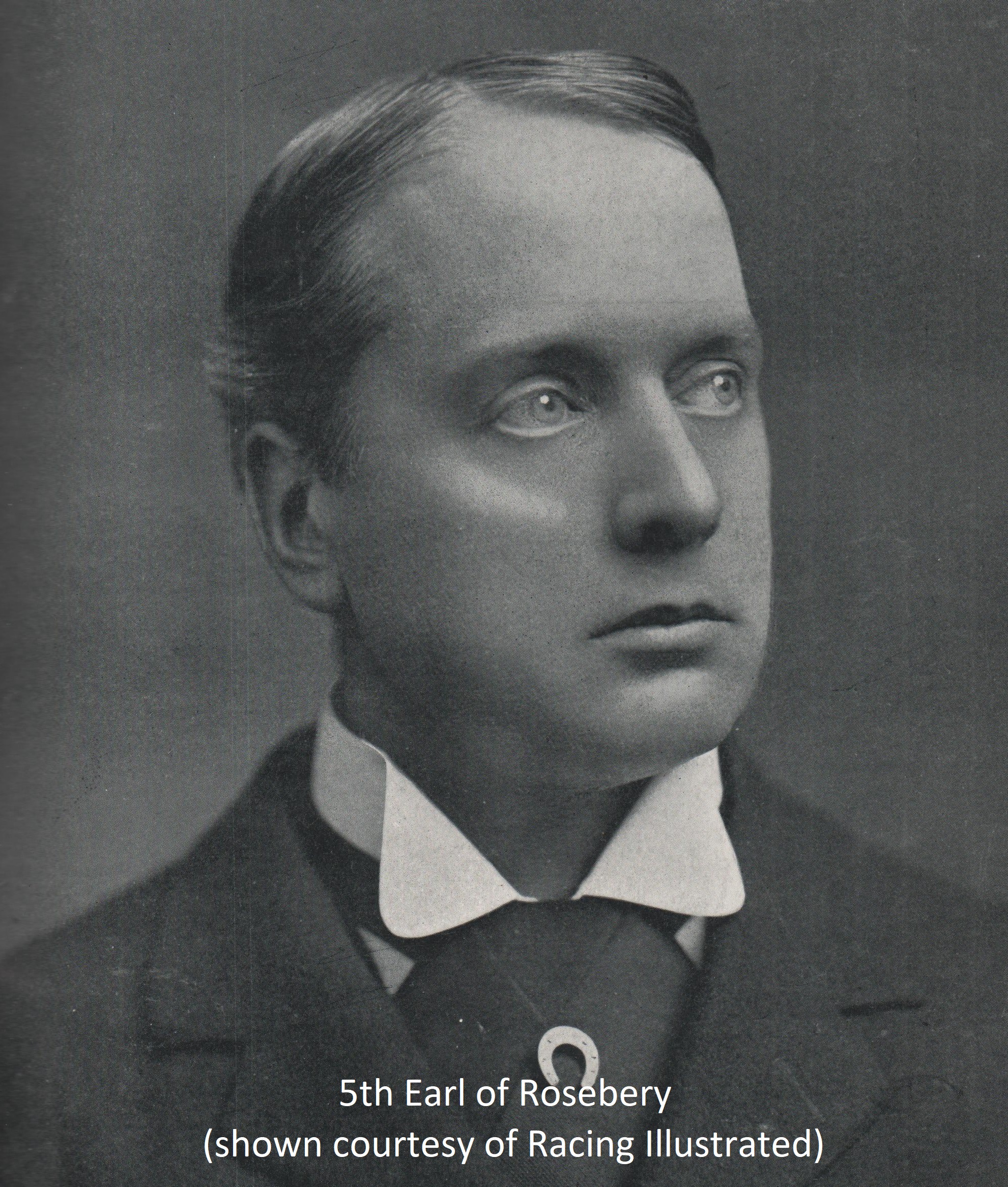
1880 Lord Rosebery, Charles Blanton, William Gosling, Harry Constable
Archibald Philip Rosebery, 5th Earl of Rosebery, married Hannah, daughter of Baron Meyer de Rothschild, and took control of Primrose Cottage Stables in 1880, initially installing William Gosling and Harry Constable as his trainers. By 1881 the trainer Charles Blanton had been installed in Primrose Cottage Stables as Lord Rosebery's private trainer, having moved across from his previous stable at Upper Station Road. Charles Blanton served as assistant trainer to Joseph Dawson before launching his own training career, representing such distinguished members of the turf as Sir John Astley, Prince Soltykoff and 'Mr Bird'. He won the 1866 Epsom Oaks with Tormentor (SR 1868) 5/1 for Benjamin Ellam Dunbar when ridden by Jimmy Mann, and the 1867 Portland Plate with Bounceaway for Prince Soltykoff well before the Prince had built Kremlin House. Charles Blanton also notched up 3 Lincoln Handicap winners; in 1869 with Sycee, in 1870 with Royal Rake and in 1875 with The Gunner at the rewarding odds of 30/1. In 1880, Blanton's stable star was Robert the Devil, a bay colt foaled in 1877 and owned by Charles Brewer. The colt remained unbeaten as a two-year-old, and was strongly fancied for the Classics. He finished runner-up to Bend Or in the 1880 Derby, beaten just a head, but went on to land the 1880 St Leger at 4/1, before also winning the Cesarewitch and Champion Stakes at the end of the season. When Charles Blanton moved to Primrose Cottage Stables in 1881 Robert the Devil showed his continued well-being by landing two races at Royal Ascot. He won the Ascot Gold Cup on the Thursday, following up in the Alexandra Plate the next day. Blanton remained with Lord Rosebery until part way through the 1882 season, after which he resumed his career with Prince Soltykoff, being replaced at Primrose Cottage by Joe Cannon.
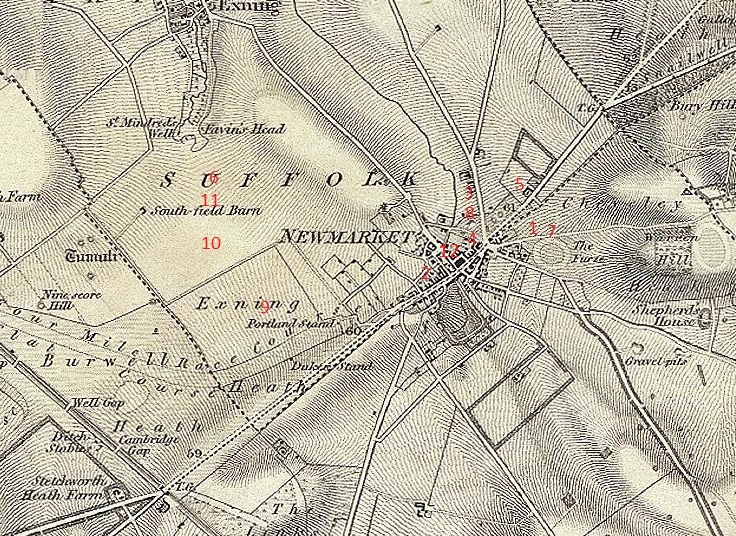
1880 Cesarewitch ROBERT THE DEVIL 17/2 owned by Charles Brewer, trained by Charles Blanton and ridden by Tom Cannon
1880 Champion Stakes ROBERT THE DEVIL 11/10 fav owned by Charles Brewer, trained by Charles Blanton and ridden by Edward Rossiter
1881 Ascot Gold Cup ROBERT THE DEVIL 4/9 fav owned by Charles Brewer and Charles Blanton, trained by Charles Blanton and ridden by Tom Cannon
1881 Alexandra Plate at Ascot ROBERT THE DEVIL 7/100 fav owned by Charles Brewer and Charles Blanton, trained by Charles Blanton and ridden by Tom Cannon
1882-September 1885 Joe Cannon, Lord Rosebery
Joe Cannon proved to be a successful trainer for a variety of employers over a prolonged period of time, taking charge of Bedford Cottage Stables on Tuesday 18th February 1873, succeeding the Bloss brothers at those Stables. This was a productive period for Captain James Machell and Joe Cannon, winning the Grand National on 3 occasions in the 1870s. In 1873 he won the Grand National with Disturbance (20/1) by 6 lengths when ridden by Mr J M Richardson, following up a year later with Reugny (5/1 fav) also winning by 6 lengths in the hands of Mr J M Richardson. In 1876 he owned Regal (25/1) who won the Grand National by a neck when ridden by Joe Cannon. However, part way through the 1882 season Joe Cannon left Bedford Cottage to take up a post as trainer to the 5th Earl of Rosebery at Primrose Cottage Stables. He had trained Rosebery's Kermesse to success in the 1881 Champagne Stakes and Middle Park Stakes, and surprised Lord Rosebery when Myra was third in the 1881 Epsom Oaks at 20/1 behind Thebais and Lord Glitters. However, two years later he won the 1883 Oaks with Bonny Jean at 5/1, and also trained the third horse Ettarre at 50/1. For the next two seasons Rosebery and Cannon enjoyed fewer high-profile successes each year which culminated in Rosebery leasing Primrose Cottage to Lord Durham in October 1885. Furthermore, as a sign he was downsizing, on Saturday 25th July 1885 Sandown races were preceded by an auction of the majority of Rosebery's horses in training. Joe Cannon was replaced by Alf Sadler once Lord Durham moved his horses across.
1881 Champagne Stakes KERMESSE owned by 5th Earl of Rosebery, trained by Joe Cannon and ridden by Tom Cannon
1881 Middle Park Plate KERMESSE owned by 5th Earl of Rosebery, trained by Joe Cannon and ridden by Tom Cannon
1883 Epsom Oaks BONNY JEAN 5/1 (SR 1845) owned by 5th Earl of Rosebery, trained by Joe Cannon and ridden by John Watts
October 1885-1894 Lord Durham, Alf Sadler snr
The 3rd Earl of Durham, John George Lambton, was born on 19th June 1855 and was known as Viscount Lambton until 1879 when, on the death of his father he inherited the title of Earl of Durham. He served in the Coldstream Guards and enjoyed horse racing. In July 1885 he had a discussion with Lord Rosebery who put his horses up for auction at Sandown races, and by October 1885 the Earl of Durham had leased Rosebery's Primrose Cottage Stables, installing Alf Sadler as his trainer. Alfred Brettle Sadler senior, grandson of Isaac Sadler who won the 1833 Epsom Derby with Dangerous, began his training career in Rottingdean, training horses for Lord St Vincent and Mr W Bevill. He moved to Stockbridge House in 1872, where one of his best early horses was Barford, later renamed Reputation. His principal patrons whilst at Stockbridge House were Lord Hastings, Lord Cholmondeley, Honourable F Lambton and Hon George Lambton. Indeed, it was a horse trained by Alf Sadler which provided George Lambton with his first ride in the Grand National in 1885 on Lioness. Another notable future racing character to be guided by Alf Sadler was Fred Rickaby who started his apprenticeship with Alf at Stockbridge House. In October 1885 Alfred Brettle Sadler was installed as Lord Durham's trainer at Primrose Cottage Stables. Alf had 4 sons and a daughter, Gladys, who married jockey and trainer Joe Cannon. His sons all forged a career in racing, training horses. In May 1894 Lord Durham moved his horses to be trained by Captain Lambton, which left Sadler with a very small string of horses owned by Mr Coombs. Alf later returned to Stockbridge and died there in early 1929 aged 82.
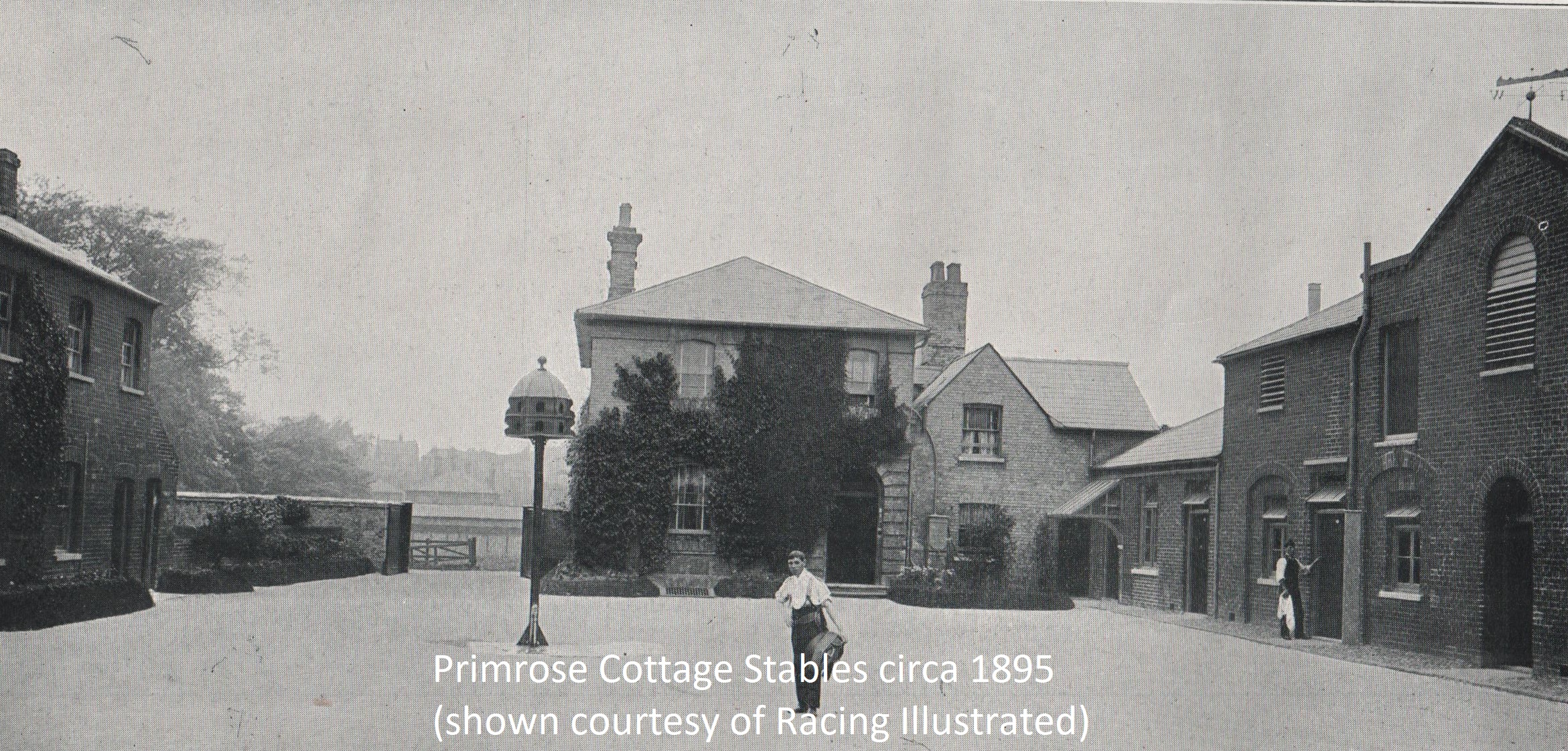
February 1894-December 1895 William Mumford
In February 1894 William Mumford, previously training at Exning, moved to Primrose Cottage Stable, taking over the lease from Lord Durham. He was predominantly a jumps trainer, winning the Cheveley Handicap Steeplechase with Rathdrum in November 1894, the horse having previously contested the Silver Cesarewitch. He was still at living at Primrose Lodge throughout 1895, where his wife oversaw the domestic staff arrangements. In December 1895, whilst riding out over the hurdles on the links course, Mumford 's horse Nugget fell at the second hurdle in a gallop against Fornham, and Mumford suffered severe internal injuries.
1894 Cheveley Handicap Steeplechase RATHDRUM 10/1 owned by Mr G Haughton, trained by William Mumford and ridden by G Morris
William Walters junior was appointed Lord Rosebery's trainer for the 1896 season and enjoyed considerable success in a few short years, particularly with Velasquez and Chelandry. The former won the New Stakes at Ascot and the July Stakes as a two-year-old, and would have had much more success at three were it not for the exceptional Galtee More. Nevertheless, Velasquez was second in the 2000 Guineas and was beaten once again into second in the Epsom Derby behind Galtee More (1/4 fav). Later in the season he came up against Persimmon (12/100 fav) in the Eclipse Stakes at Sandown, but did enjoy success of his own in the Prince of Wales's Stakes at Newmarket. Walters guided Chelandry to victories in the National Breeders Produce Stakes and Woodcote Stakes in her two-year-old days, going on to win the 1897 1000 Guineas, before running second in both the Oaks and St Leger. Walters was replaced by Charles Wood in July 1898.
1896 New Stakes at Ascot VELASQUEZ 11/10 fav owned by Lord Rosebery, trained by William Walters jnr and ridden by John Watts
1896 July Stakes VELASQUEZ 2/11 fav owned by Lord Rosebery, trained by William Walters jnr and ridden by John Watts
1896 National Breeders Produce Stakes at Sandown CHELANDRY 3/1 owned by Lord Rosebery, trained by William Walters junior and ridden by John Watts
1896 Woodcote Stakes at Epsom CHELANDRY 1/3 fav owned by Lord Rosebery, trained by William Walters jnr and ridden by Tommy Loates
1896 Craven Stakes at Epsom BERKELEY 7/2 owned by Lord Rosebery, trained by William Walters jnr and ridden by Toon
1897 1000 Guineas CHELANDRY 9/4 (SR 1971) owned by 5th Earl of Rosebery, trained by William Walters jnr and ridden by John Watts
1897 Prince of Wales's Stakes at Newmarket VELASQUEZ 85/40 (SR 1986) owned by Lord Rosebery, trained by William Walters jnr and ridden by John Watts
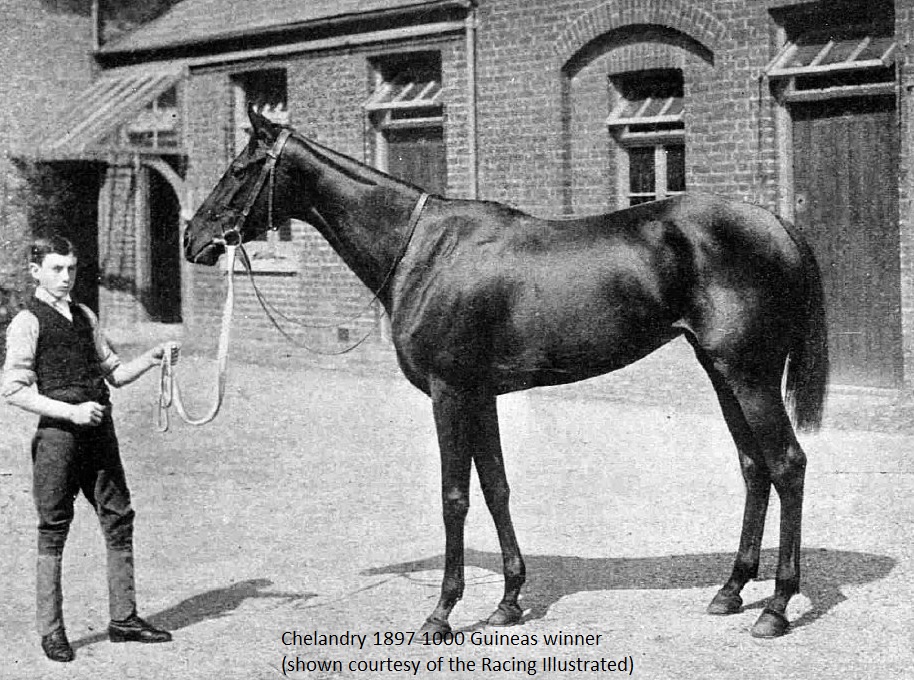
In July 1898 Walters was replaced by Charles Wood who continued to ride at the same time as training. He guided Velasquez to success in the Champion Stakes for the 5th Earl of Rosebery at 4/11 fav. In October 1900 Lord Rosebery decided to sever all his connections with the turf, sending all of his horses in training to Newmarket to be sold on Thursday 25th October 1900.
November 1902 James R Keene, Matthew Allen
In November 1902 Mr James R Keene's personal trainer, Matthew Allen, moved to Primrose Cottage Stables in readiness for the 1903 Flat season. James and Foxhall Keene were thoroughbred owners from America. Mr Foxhall Parker Keene, son of James R Keene, was born in New York State on 18th December 1867 and he and his father fully embraced their love of racing. James was the president of the San Francisco Stock Exchange and also the owner of the famous racehorse Foxhall who he named after his son. When James transferred 13 of his thoroughbreds to England in 1880, he enjoyed tremendous early success. Foxhall won the 1881 Grand Prix de Paris, also securing a seldom achieved Autumn Double with the 1881 Cesarewitch and Cambridgeshire. A year later Foxhall won the 1882 Ascot Gold Cup for James. The Keene's racing silks, blue with white spots, adorned the winners enclosure frequently, many times in high profile races. Father and son ran the Castleton Farm racing stable in Lexington, Kentucky, but Foxhall also owned a racing stable at Melton Mowbray. In November 1902 James R Keene took over the lease of Primrose Cottage Stables, installing Matt Allen as his trainer and making use of the American jockey Lucien Lyne. While the team enjoyed many successes in the 1903 season, including a creditable fourth place by Dazzling in the 1903 1000 Guineas, by 1904 James had decided to sell his horses in training and disband the team. Allen returned to the States in late December 1903 and his long training career there continued up to 1910. He was later appointed Timekeeper to the New York Jockey Club, but had to retire on the grounds of ill-health shortly before his death at his home on 26 June 1918.
1903 City of London Breeders Foal Plate at Sandown SURBITON 9/4 owned by James R Keene, trained by Matt Allen and ridden by Lucien Lyne
1903 Swaffham Welter Handicap at Newmarket HURST PARK II 100/7 owned by James R Keene, trained by Matt Allen and ridden by Lucien Lyne
1903 Bradgate Park Plate at the St Leger meeting FLYING PRINCE (evens fav) owned by James R Keene, trained by Matt Allen and ridden by Lucien Lyne
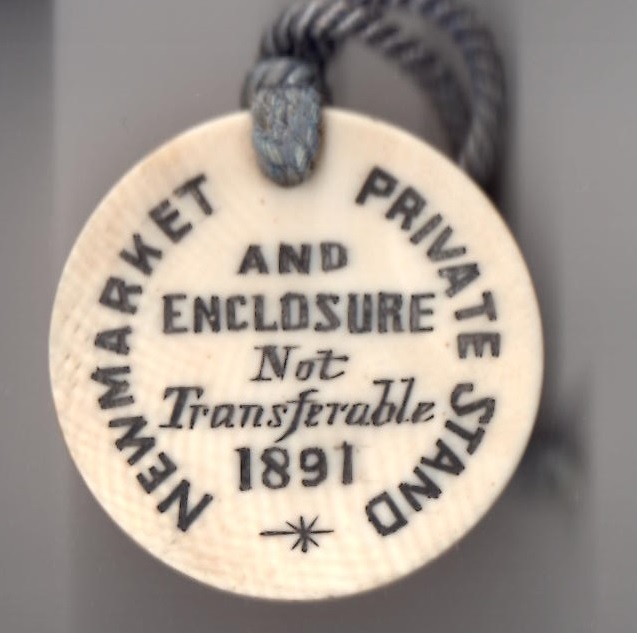
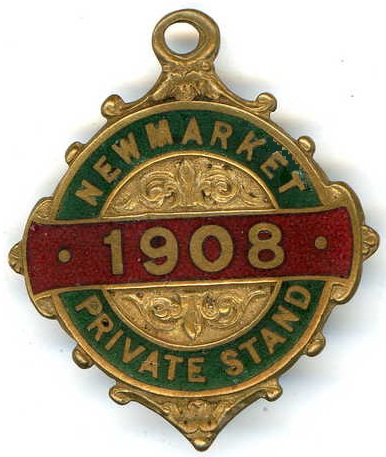
1907 Juan Torterolo
The Argentinian trainer Juan Torterolo, who trained horses in France in the 1920s and sent Taj Mah (SR 1943) over to Newmarket to win the 1929 1000 Guineas when owned by Simon Guthmann and ridden by Wally Sibbritt, owned racehorses stabled at Primrose Cottage in 1907. In particular, the 2-year-olds Rothschild and Hurrah were owned by him and put up for sale in late 1907.
1911-1915 Basil Jarvis
Basil Ernest Jarvis, born at Newmarket on 11 October 1886, the second son of William A Jarvis, became apprentice to his father, although his riding career was short. He then began training, holding a Flat licence from 1909 to 1949, and launching his training career at Boyce House in 1909. Basil Jarvis left Boyce House and stables at the end of 1911, moving to Primrose Cottage. He closed down his stable there at the end of 1915 to become Private B E Jarvis before being promoted to Lance-Corporal. In 1921 he moved to Green Lodge stables where he remained until 1939.
1921 Vernell Hobbs, Frank Curzon
The actor and racehorse breeder, Frank Curzon, took ownership of Primrose Cottage after the War, installing Vic Hobbs as his first trainer. Frank was well known in theatrical circles, both as a manager and a producer, residing at Primrose House between 1921 and 1925 so that he could easily pursue his interest in horse racing. He had won the 1920 Chester Cup a year earlier with Our Stephen, named after the top jockey Steve Donoghue. He bought Primrose House from Mrs E Gray who had lived there during the War years. Vernell Hobbs was private trainer to Mr C B Ismay in the latter part of the First World War, leaving at the end of the 1920 season. Mr C B Ismay, brother to Bruce Ismay, owner of the White Star Shipping Liner and a survivor of the Titanic disaster, employed Vernell Hobbs until he was enticed away by Frank Curzon. Mr C B Ismay died shortly afterwards in May 1924. Whilst Mr Hobbs did not train the winners of principal races during his short time working for Curzon, he did win minor event with Magical and Sanover. After a year Vernell Hobbs was replaced by John (Jack) Watts, and later took up a training position in Lambourn.
1921 Gatwick 3-y-o Handicap MAGICAL 3/1 owned by Frank Curzon, trained by Vernell Hobbs and ridden by G Walsh
1921 Hastings Nursery Handicap SANOVER (Evens fav) owned by Frank Curzon, trained by Vernell Hobbs and ridden by G Walsh
1921 Mickleham Selling Plate at Epsom on Oaks day SANOVER 10/1 owned by Frank Curzon, trained by Vernell Hobbs and ridden by G Walsh
1922-December 1927 Frank Curzon, John (Jack) Watts
John Evelyn (Jack) Watts had begun his racing career at the German Government Stud until World War I halted his training career. He served in the Suffolk Yeomanry during the War, and immediately after the War had ended, he began training at Lansdowne House, Newmarket. However, in 1922 he was enticed by Frank Curzon to train for him at Primrose Cottage Stables. Frank had bought the place in 1921, but after suffering ill-health in 1923 he thought seriously about giving up his interest in racing. However, although he sold Primrose House to Sir Archibald Gold, he retained possession of Primrose Cottage and Stables, persevered with racing and in 1924 he bred a colt which won him the Derby. Call Boy, a chestnut colt by Hurry On out of Comedienne, was foaled in 1924 at Primrose Cottage Stud and owned by Frank Curzon. By the time Call Boy was ready to begin his racing career in 1926, Curzon had sold Primrose Cottage to Gold but retained use of the Stables, only transferring trainer Jack Watts, and Call Boy to Lansdowne House Stables in December 1927. He won the Middle Park so impressively at two that he was installed as 5/2 favourite for the 1927 2000 Guineas. He was beaten a short head by Adam's Apple (SR 1983), but quickly made amends by winning the Newmarket Stakes by an impressive 4 lengths. In the 1927 Epsom Derby, ridden by Charlie Elliot, Call Boy (SR 2049) won by 2 lengths at 4/1. Owner Curzon was unwell at the time of the Derby, attending against his doctor's advice, and shortly after the race he died. This prevented Call Boy from taking his chance in the St Leger, and he was immediately sent off to begin his stud career.
1922 Newmarket Breeders 2-y-o Stakes EAGERFORD 5/2 jt fav owned by Frank Curzon, trained by Jack Watts and ridden by Whalley
1922 Chaplin Nursery Plate at Lincoln FOREST GLADE 9/2 owned by Frank Curzon, trained by Jack Watts and ridden by H Leach
1923 Rothschild Maiden Plate GREENAWAY BOY 9/100 fav owned by Frank Curzon, trained by Jack Watts and ridden by R Jones
1923 Melton Stakes at Leicester GREENAWAY BOY 11/10 fav owned by Frank Curzon, trained by Jack Watts and ridden by R Jones
1923 Atherstone Handicap at Leicester HARPENDEN 3/1 fav owned by Frank Curzon, trained by Jack Watts and ridden by Charlie Elliott
1924 Durdans Handicap at Epsom RAGOUT 4/1 owned by Frank Curzon, trained by Jack Watts and ridden by R Jones
1924 Newmarket Breeders 2-y-o Stakes EGYPTIAN IDOL 5/2 fav owned by Frank Curzon, trained by Jack Watts and ridden by R Jones
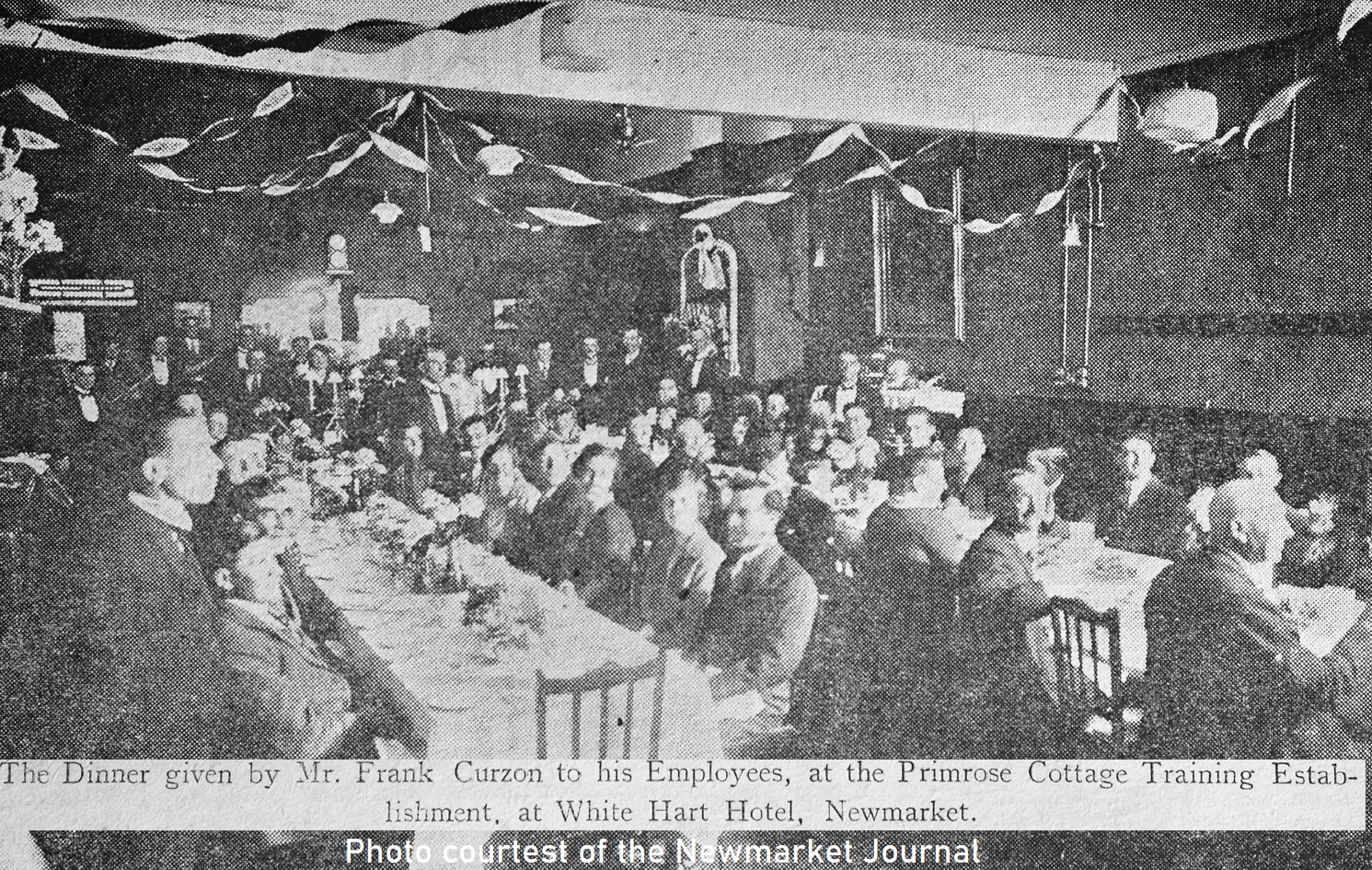
Call Boy, a chestnut colt by Hurry On out of Comedienne, was born in 1924 at Frank Curzon's Primrose Cottage Stud in Newmarket. In a career spanning 7 races he was successful 4 times, winning the Linton Stakes and Middle Park Stakes at Headquarters, having previously been beaten in the July Stakes, and running second in the Champagne Stakes at Doncaster. He was trained at Primrose Cottage Stables by John (Jack) Watts and was made favourite for the 1927 2000 Guineas, although he was beaten a short head by Adam's Apple (SR 1983) at 20/1 owned by Charles Whitburn. He then won the Newmarket Stakes by an impressive 4 lengths and, on the back of this win, was made 4/1 favourite at Epsom, where he duly obliged by 2 lengths from Hot Night. Owner Frank Curzon was advised not to attend by his doctor, but was determined to do so. When the horse won, King George V, seeing how ill Curzon was, invited him to receive his trophy at Buckingham Palace. Curzon, determined to carry on as if nothing was wrong, declined, instead climbing the Epsom stairs to receive his trophy. Frank Curzon died a few days later, while Call Boy went off to stud without racing again.
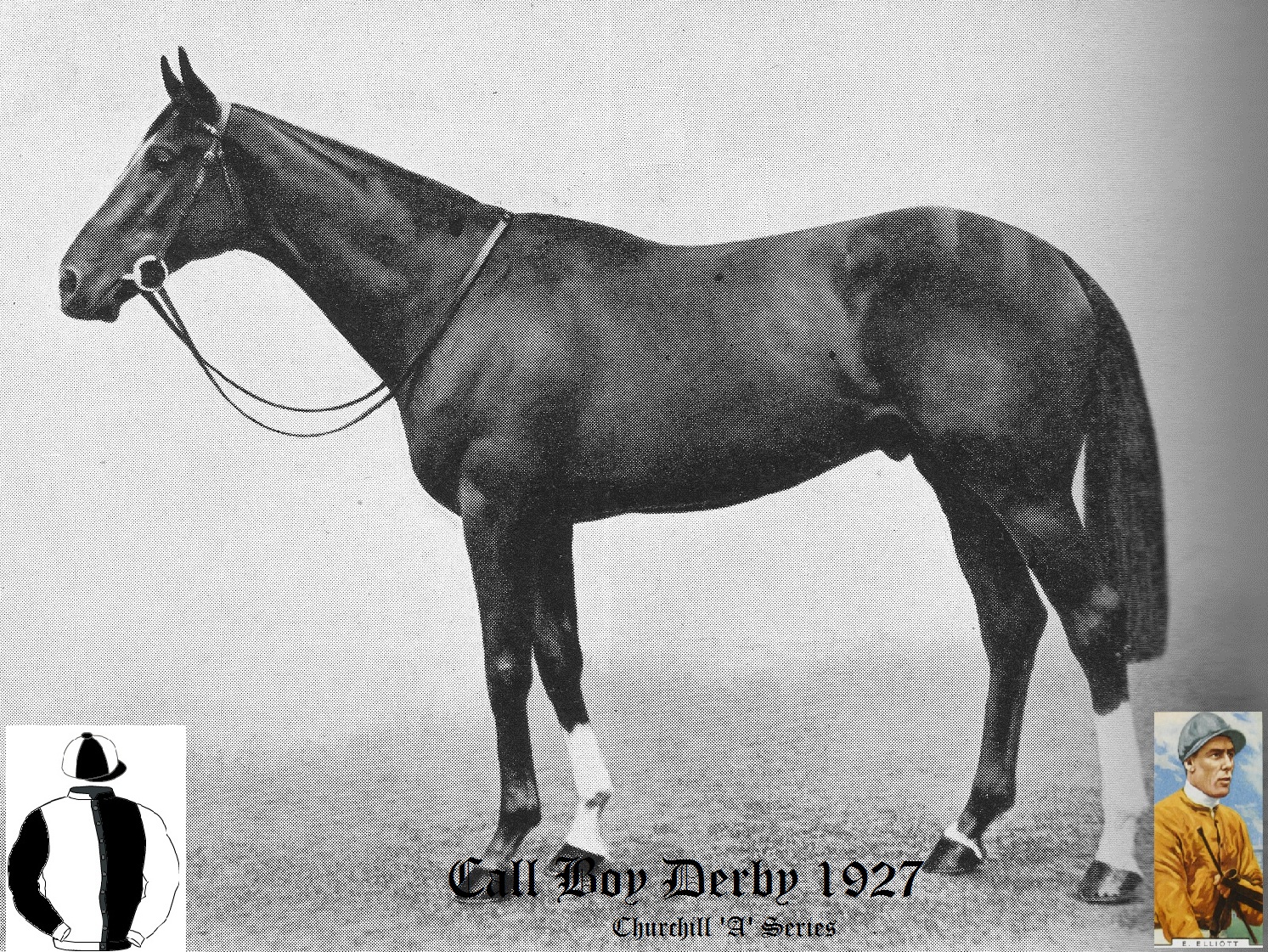
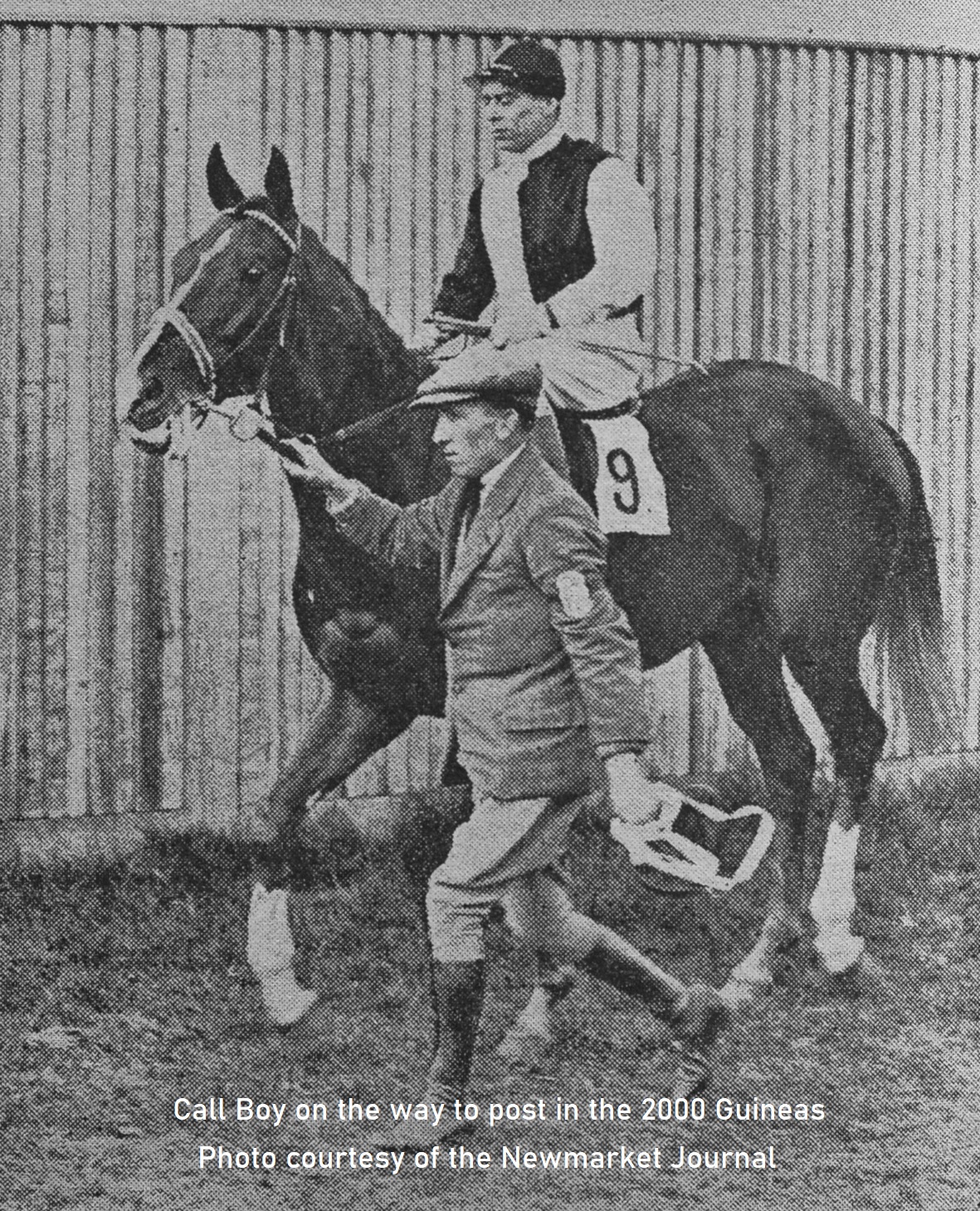
December 1927-13th June 1933 George (Fred) Leader
George Frederick Leader, second son of renowned trainer Tom Leader, was born at Wroughton, Wiltshire in 1881. He became an apprentice for his uncle, William Leader, at Barcelona House in Wroughton, before becoming his assistant trainer, later travelling to America to gain further experience with Andrew Joyner. After a spell at Warren House Stables, George (Fred) Leader transferred to Primrose Cottage Stables in December 1927, acquiring it from Frank Curzon and replacing John (Jack) Watts. In August 1929 Fred's apprentice, Tommy Lowrey, fractured his collar bone riding Fingle Bridge in the Stewards Cup at Goodwood, when the horse unexpectedly fell. Fred remained at Primrose Cottage Stables until his tragic death on 13th June 1933, when he and his wife were killed in a motoring accident whilst returning from Ascot races where they had enjoyed watching their horse, Gainslaw, win the Ascot Gold Vase.
1925 Liverpool Cup WINALOT 5/1 owned by Joseph Shepherd, trained by Fred Leader and ridden by Henri Jellis
1925 Manchester Cup WINALOT 11/2 owned by Joseph Shepherd, trained by Fred Leader and ridden by Dick Perryman
1925 Old Newton Cup WINALOT (Evens fav) owned by Joseph Shepherd, trained by Fred Leader and ridden by Henri Jellis
1926-1932 Frank Barling
Straight after the end of the First World War Francis (Frank) William Bonner Barling, who originated from Ross in Herefordshire, trained at Falmouth Lodge for Lord Glanely, 1st Baron Glanely. He reached the pinnacle of his career when he trained the unexpected winner of the 1919 Epsom Derby Grand Parade (SR 1968) at 33/1, ridden by Fred Templeman. It proved to be a spectacular year for both owner and trainer, recording 7 wins at Royal Ascot. Frank left Falmouth House the next year due to ill health, but began training again in 1925 and 1926 at La Grange, owning and living in Amberley House, and by 1931 had moved on to Kremlin House, although a period of bankruptcy put the brakes on his career. Throughout the time he operated from the various stables listed, he was also running a private stable from Primrose Cottage, passing it on to his son, Geoff Bonnor Barling, in 1932. Frank died in Newmarket on 17th April 1935.
1926 July Handicap at Alexandra Park INSCRUTABLE 5/2 owned by Mr Benjamin, trained by Frank Barling and ridden by J Caldwell
1927 Chesterton Stakes HELVIA 5/1 owned by Mr Benjamin, trained by Frank Barling and ridden by Henri Jelliss
1928 Croxteth Stakes at Liverpool INSCRUTABLE 4/6 fav owned by Mr Benjamin, trained by Frank Barling and ridden by J Dines
1930 Stockton Spring Handicap GOOD MINT 10/1 owned and trained by Mr F B Barling and ridden by J Simpson
1931 Killingworth Stakes at Newcastle TITTLE TATTLE 2/5 fav owned by Mr Markham, trained by Frank Barling and ridden by P Beasley
December 1932-December 1933 Captain Whitaker
Captain Percival Ayfon Onley Whitaker, born in Suffolk on 31st May 1870, was educated at Wellington College before launching a successful military career firstly in the Sussex Harriers and later in the Essex Militia. He was a noted amateur jockey, winning the Amateur riders Championship in 1907 with 30 wins, although his most successful year was in 1908 when he won the Championship again, with 26 wins, but also partnered Rory O'More to success in the 1908 National Hunt Steeplechase. He then finished third on Lawyer III in the Grand National behind Rubio, but the horse died the next day, and in a post-mortem it was revealed Lawyer III had only one lung. Percy was an equally accomplished trainer on the Flat and over jumps. In 1923 he partnered Silvo to success in the Aintree Grand Sefton Chase before the horse finished a creditable 3rd in the 1924 Grand National behind Master Robert. In 1929 Percy moved his training base from St Giles, Salisbury to Paddock Cottage, Newmarket where he achieved some of his best Flat race wins. These included Knight Error winning the 1931 Lincoln Handicap, but in January 1932 Captain Whitaker leased Hackness Villa Stables from George Blackwell. He was at Hackness Villa until March 1935, although he is thought to have leased some boxes at Primrose Cottage for a year in 1933.
December 1933-August 1934 Walter Earl
As well as the Barlings training at Primrose Cottage Stables, Walter Earl had horses there from December 1933, living in Lincoln Lodge where Skeets Martin had previously lived, and Earl remained for most of the 1934 season, having moved from Kremlin House, although in September 1934 he moved all of his horses to Heath House Stables.
1932-73 Geoff Barling
Geoffrey Bonnor Barling, born on 24th June 1902 at Amberley Court in Monmouth was always likely to spend his life with horses, his father being a vet and trainer,while his grandfather was a farmer. He first took out a licence in his own right in December 1931 training 10 National Hunt horses at Kremlin House, but by 1932 he had gained a Flat trainer's licence as well. Although he assisted his father at Kremlin House, the ill health which his father suffered from meant that his father's career was coming to an end in late 1933, and Kremlin House was sold to George Lambton. Although Geoff was given permission to remain there temporarily, he then transferred to Primrose Cottage stables where he remained, but for a period during the War, until 1973. After his father, Frank Barling, had completed his training stint at Primrose Cottage Stables, son Geoff took control in 1932, although he had taken control in October 1927 when Frank was convalescing in a nursing home with a debilitating illness. However, his father had also spent some considerable time at Kremlin House which he owned, and Geoff was also training there between December 1931 and early 1934. When War broke out Geoff became a second lieutenant in the Light Anti-Aircraft Battery, alongside George Archibald, Bernard Van Cutsem, Bill Rickaby and Henri Jelliss. During the War Primrose Cottage Stables were requisitioned by the Ministry of Food, but once the War ended Geoff was able to resume his career at Primrose Cottage, remaining there until his retirement in 1973. During his 5 decades at Primrose Cottage he trained 6 Royal Ascot winners, including back-to-back wins in the Ascot Stakes in 1938 and 1939 with Frawn. He also celebrated a Royal Hunt Cup victory in 1960 with Small Slam, and landed the Ribblesdale Stakes in 1968 with Pandora Bay.
1938 Ascot Stakes at Royal Ascot FRAWN 5/1 fav owned by J Westoll, trained by Geoff Barling and ridden by Eph Smith
1939 Ascot Stakes at Royal Ascot FRAWN 100/8 owned by J Westoll, trained by Geoff Barling and ridden by Eph Smith
1957 Fern Hill Stakes (Sandringham Stakes) at Royal Ascot INSTOW 100/7 owned by Mrs L Prior, trained by Geoff Barling and ridden by F Barlow
1960 Royal Hunt Cup at Royal Ascot SMALL SLAM 28/1 owned by Mr King, trained by Geoff Barling and ridden by Bobby Elliott
1965 Fern Hill Stakes (Sandringham Stakes) at Royal Ascot PETTY CASH 5/2 fav owned by Mrs C Phillipson, trained by Geoff Barling and ridden by M L Thomas
1968 Ribblesdale Stakes at Royal Ascot PANDORA BAY 11/4 jt fav owned by Major C Nathan, trained by Geoff Barling and ridden by M L Thomas
Post 1973
Primrose Cottage stables stood on 4 acres of prime land which the Urban District Council had wanted for some time prior to 1973. Discussions about a Newmarket Link Road had seemed never ending, but in September 1973 the UDC purchased the site by compulsory order, to enable them to build a car park as part of an extended Rookery development project. Geoff Barling was given permission to remain at Primrose Cottage until January 1976, as the developers were not ready until that date to begin their work on the site. Geoff moved to Woodlands, in Cheveley, remaining there until his death on 10th October 1984.
CALL BOY (1927 Epsom Derby)
CHELANDRY (1897 1000 Guineas)
HIPPIA (1867 Epsom Oaks)
TOMATO (1865 1000 Guineas)
BONNY JEAN (1883 Epsom Oaks)



